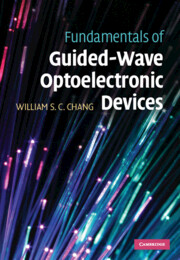6 - Channel waveguide components
Published online by Cambridge University Press: 25 January 2011
Summary
Fields in channel waveguides are confined to the vicinity of the core within a few μm in both the lateral and the depth directions. There are two main advantages of the lateral confinement of channel guided-wave modes:
(1) The RF electric field required to obtain an electro-optical effect such as electro-optic change of index or electro-absorption needs only to exist in a small region around the core. The required electric field in a small region can be achieved with just a moderate RF voltage applied to the electrodes. Furthermore, when the electrodes are fabricated parallel to the channel waveguides, the electro-optical change of index or electro-absorption produced by a propagating RF signal can be synchronized with the propagation of the guided wave in a traveling wave interaction as discussed in Chapter 4. Thus the electro-optical modulation at high frequencies may be carried out effectively.
(2) Most optoelectronic devices are eventually connected to single mode optical fibers. The optical field pattern of the channel waveguides can be designed such that it matches well with the field pattern of single mode optical fibers or tapered fibers, providing high efficiency transmission of optical power to and from the low loss single mode fibers.
Traditionally, guided-wave devices have been discussed in the literature according to the type of optical interactions they utilize, such as directional coupling or electro-absorption.
- Type
- Chapter
- Information
- Fundamentals of Guided-Wave Optoelectronic Devices , pp. 148 - 196Publisher: Cambridge University PressPrint publication year: 2009



